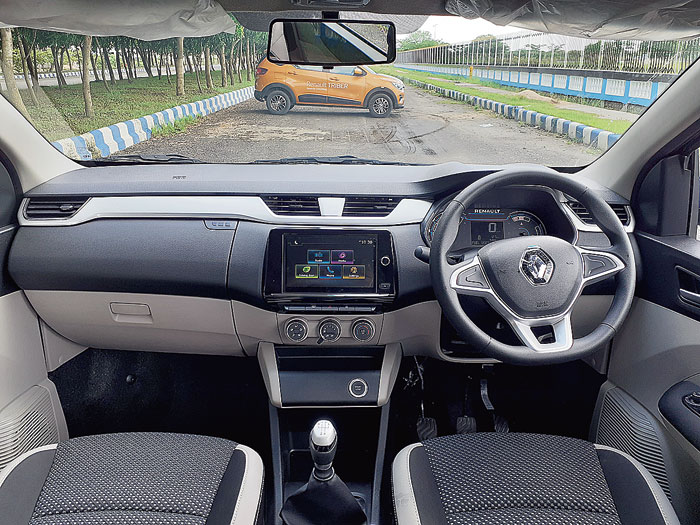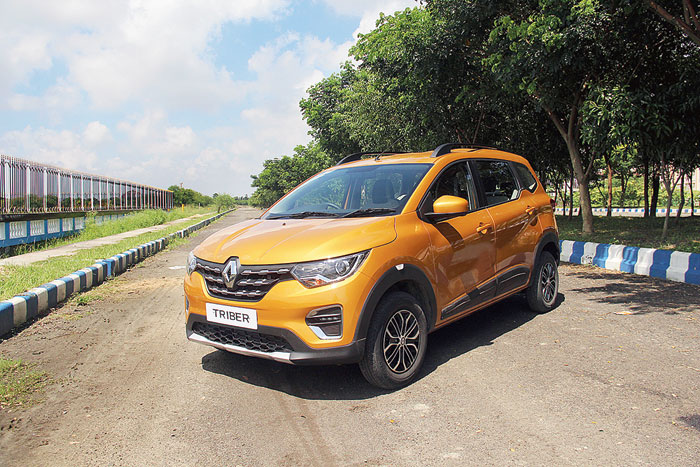Renault’s just-launched Triber is certainly one of the more interesting cars to hit the roads in recent times. It is one of the few vehicles in the market that tries to pack in space for seven people into a sub-four-metre footprint so it attracts a lower rate of tax and, consequently, remains affordable.
To be fair, it isn’t the first vehicle in the market to offer this mix. The Datsun Go+, for instance, offers a similar combination. So, what does the Triber bring to the table?
The Telegraph took the top variant, RxZ, for a spin to find out about it first hand.
The exteriors
India is the first market that the Triber has been launched in and it’s a product that has been developed with this and other similar markets in focus. It’s quite a handsome vehicle and appears right up there with more expensive cars.
While it is certainly a fairly compact people mover, the design isn’t like a breadbox that one might expect it to be. Nor does it look like an estate car. If anything, it looks more like a somewhat longer hatchback than anything else.
Up front is the signature Renault grille and neat headlamp clusters. The overall stance is quite broad, planted and SUV-like — an impression that the manufacturer tries to emphasise with a bumper insert that mimics a scuff plate. (There’s one in the rear bumper too.) With its 182mm ground clearance, the Triber stands well off the ground and gives the impression that it can tackle bad roads.
The sides have nice contouring and a little kink at the C-pillar in the swept-up shoulder line adds character to the look. It has also got roof rails that can bear loads of up to 50kg. Also, because of the rails, one tends not to notice that the roof is stepped up over the rear seats.
The back is clean and uncluttered with large, nicely-designed wraparound tail lights dominating the look. The car normally comes with plain-vanilla five-spoke alloys, but the accessory alloys that the car we drove rode on are quite desirable and improve the looks.

Koushik Saha
The interiors
This is where Renault has put most of its focus. We had mentioned the stepped-up roof earlier. The need for that arises because of the stepped-up floor of the vehicle. So, the second row is set a little higher than the first and the third row a little higher than the second, a bit like a movie hall. So, to create headroom for the occupants of the back rows, the roof, too, has had to go up a bit. Because of the step, however, the car doesn’t look too tall from the front. This has been done quite cleverly.
Considering that the seating is this vehicle’s major reason for being, here’s what’s on offer. The Triber, says Renault, is built on a new platform that allows it to have a passenger compartment that takes up nearly 3m of it’s 4m length.
The driver and front passenger seats move forward and back. So does the second row. The two third row seats come in two bags and can be mounted or unmounted as needed in a couple of minutes. One can also mount one of them and create a six-seater with some extra luggage space. Renault says you can have seven-, six-, five-, four-, three- or two-seat configurations in the car! The second row is split 60:40 and can fold down and flip forward creating a very large area for luggage.
The Triber has a very usable third row of seats. Yes, one does sit with the knees up somewhat, but not too much. And leg space was quite good after adjusting for a driver and middle row occupants of about 5’10”. This is a genuine seven-seater that can accommodate adults in reasonable comfort in the last row, at least for medium distances.
Now, this car has been made to a price. But the good thing is, that has not been made obvious. The interior plastics are hard, but have a design similar to the soft-feel stuff and there’s no cheapness to the feel of the touch points like various stalks, knobs, door handles and so on. Overall, it feels well put together and should hold up well over time.
The design, too, is good. The dash has silver inserts and there are a few bits in the door too. Including the silver plastic, the dash is a three-tone affair with pride of place going to the eight-inch central touchscreen infotainment unit that also supports Apple Car Play and Android Auto. The instrument cluster is also an LED screen now.
There’s a lot of storage, too, with two cooled boxes — one each on the dash and in the central console. There’s also a second glove box. The boot capacity in the five-seater combination is 625litres, but with seven up, it goes down to 84litres.
There are separate cooling vents for the second and third rows and company officials said there is a separate cooling coil for the two rear rows of seats. These rows also get a 12V socket each and the middle gets USB connectivity too. There’s a USB port and auxiliary input jack in front too. A shelf above the starter button is good for things like phones.

The third-row EasyFix seats come in their own bags and can be installed in a couple of minutes Koushik Saha
Large glass areas make the cabin feel quite airy and even those in the third row get to look out of the side and not feel boxed in. And the audio system is quite decent. The car we drove came with power windows and power adjust for the outside mirrors as well. Depending on the variant, there will be either two or four airbags.
The drivetrain
The Triber comes only with a 999cc, three-cylinder ‘Energy’ petrol engine that is being used for the first time in India. This unit also does duty in the company’s Clio and Sandero models. It’s a peppy engine that is quite eager to deliver its power and torque.
The job of the transmission in the Triber is to give it enough shove, considering that is running a smallish engine. So, expectedly, the lower gears of the five-speed gearbox seemed pretty close. The throws of the shifter are on the longer side but slot in well enough.
The drive
The engine makes 72ps of power 6,250rpm. The more relevant bit, however, is that it has a torque output of 96Nm at 3,500rpm and most of it comes in a nicely progressive way. The Triber is a lightweight vehicle, but with this engine, it won’t burn the tarmac. The power flows nicely above 2,000rpm and the Energy engine delivers enough, well, energy, to make the Triber a surprisingly nice drive.
Driving in slower traffic isn’t a problem either. The steering is very light and so is the clutch. This vehicle isn’t designed for performance but for fuel economy. While it may not achieve the certified figure is 20kmpl in real world stop-go traffic that it would negotiate in most places, it should still return decent numbers.
The Triber handles bad stretches without much of a problem and keeps passengers well insulated from the road. Thankfully, it doesn’t have the pogo-stick effect on bad roads. Direction changes at reasonable speeds are handled pretty well even though it’s a tallish vehicle with decent ground clearance and rides on narrowish 165/80 radial tyres. This is a car for the tarmac and should be kept there without getting carried away by the skid plate motifs. Okay, it would handle mild off-road stretches too.
The call
There are quite a few things that Renault has tried to achieve with the Triber. It has tried to create a vehicle that will carry seven people but come in under 4m to keep prices down. It has tried to build a vehicle that is easy on the pocket, but isn’t a bare-bones box that makes it obvious that it has been built to a low price. The Triber tried to be something that is likely to hold up well, and, of course, look good. At the same time it wants to be frugal on fuel and flexible in use. That’s a fairly long list and Renault seems to have managed to achieve its objectives.
At its price level, the Triber is quite a good deal. It would probably be better to go for one of the two higher variants and not the entry-level one since those will have most of the goodies that strengthen the case for buying this car, particularly for those who need to travel with lots of people.











